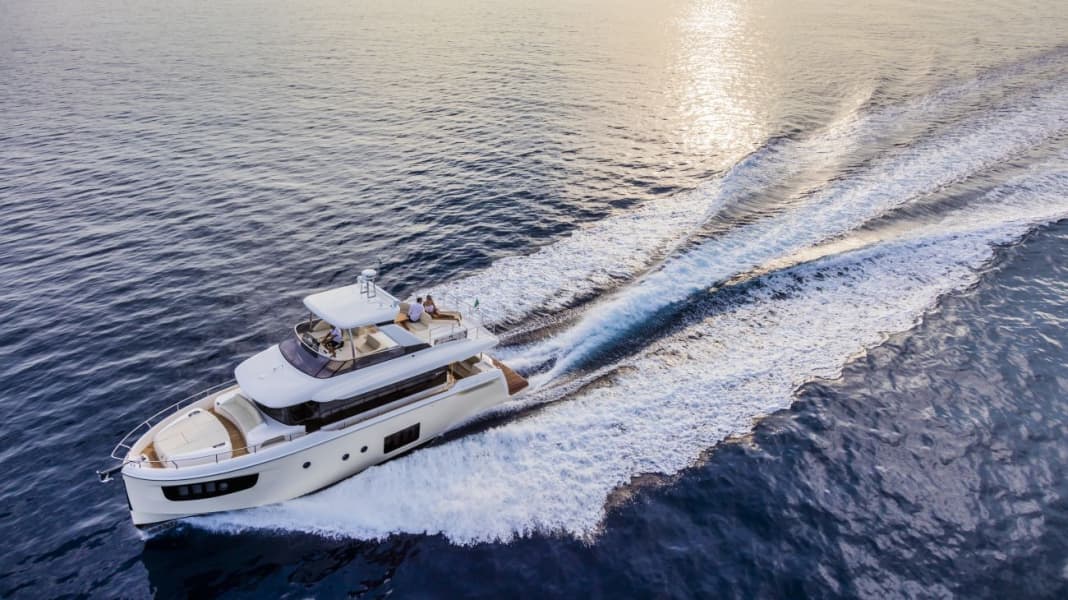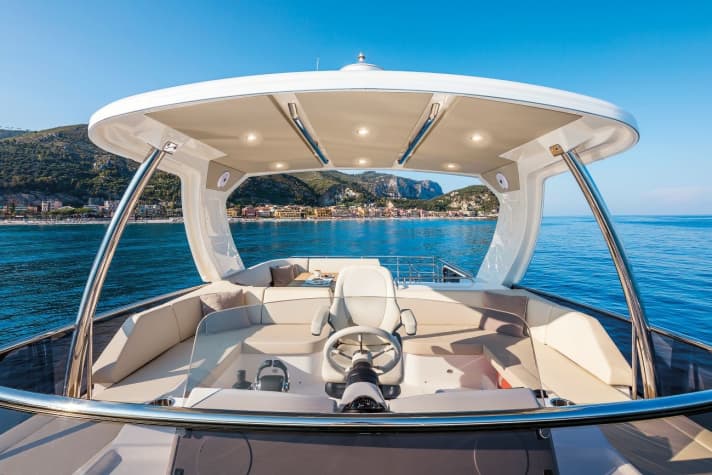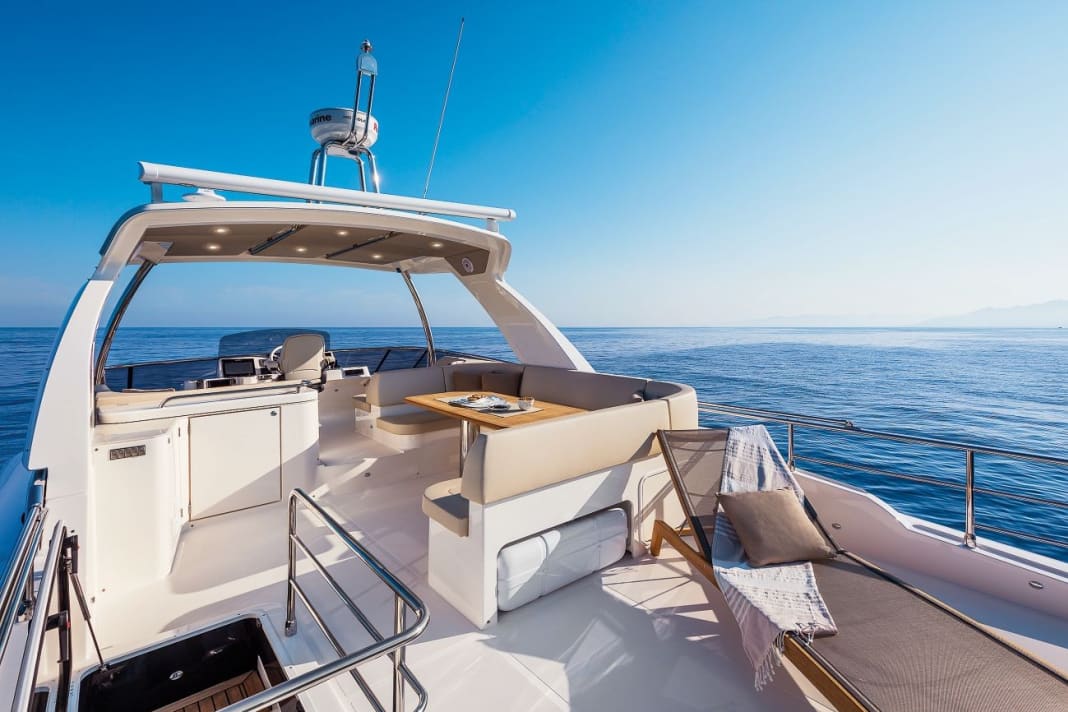
In the January 2015 issue wethe big sister Navetta 58 as a dream in turquoise. Now we are sailing the six-foot smaller Navetta. Both have the same genes and don't differ too much: expansive flybridge with or without T-top, sunbed at the front with bench seat in front of the windscreen, side decks covered by the flybridge, covered cockpit, saloon with large windows all round and bathing platform.
Even the shape and number of windows and portholes in the hull are unchanged.
And the number of cabins below deck is no less: three plus one. However, while there are three bathrooms with toilets in the large cabin, there is one less unit in the smaller one. However, this is due to the dimensions, as the Navetta 52 is one metre shorter and 35 cm narrower.
However, this does not mean that the space is not just as generous. This is particularly impressive in the bow or VIP cabin, where the double berth is not lengthways, but with the short side, i.e. the head end, adjacent to the port side. This creates space anda marvellous view thanks to the window fronts outside.

From this cabin there is direct access to the day bathroom with toilet on the port side. This is followed by the second unit, which is only accessible from the owner's cabin. It also extends across the entire width of the boat and offers a host of amenities, such as window fronts on both sides. The guest cabin is still equipped with two single berths.
The difference is only noticeable in the saloon, where in the Navetta 52 the galley is located right at the entrance to the saloon on the port side and also serves as a bar for guests in the cockpit. The large, U-shaped bench seat has now been moved forwards and also fulfils the function of the dinette. Behind the driver, where the galley is located in 58, is a small bench seat.
accommodated. The helm station remains on the starboard side and is also equipped with everything that digital technology has to offer in the 52 - for example with a touchscreen that displays everything to do with boat and engine technology. The compass remains analogue, and thanks to a door, the skipper can quickly access the side deck.
The choice of engines is limited to two Volvo Penta D6 IPS-600, each of which delivers 435 hp to the pod drives. This type of drive is connected to joysticks as standard, which can be used to move the boat in any direction at slow speed. This makes mooring and casting off a breeze, even for the less experienced skipper.
We sail the slow passages at a maximum of 6 knots so that the waves generated by the boat do not disturb us.
Without trimming too much, the test boat switches from displacement to planing speed and always runs in the green zone from 2600 rpm, which is also the lowest planing speed (12 knots), up to full throttle (25 knots). In other words, it is always economical, because one tank of fuel is enough for Theoretical ranges of around 320 nm plus 15 % reserve good.
But not enough for a trawler. For longer distances in one go, you have to go slowly. At a speed of 6 knots, it's about 1800 nm plus reserve. Thanks to effective sound insulation, the sound pressure level in the saloon does not exceed that of a normal conversation, even at full throttle.
The chapter on extreme manoeuvres is short thanks to IPS drives, as nothing extreme happens. The turning angles of the drives are determined by the rpm and speed, which means that any turns are slightly extended when gliding.
And only if you crank the rudder fast enough will the boat sway slightly over its longitudinal axis. That was all. We can't say anything about the rough water behaviour of our test boat either, as Poseidon had a rest day off Varazze in Italy.
At least when sailing over its own waves and those of fishing boats, the hull gives the impression that it can also handle larger calibres.
Absolute has been operating at a high level in terms of workmanship and materials used since it was founded and has endeavoured to maintain and improve this level. We say "successful" in every respect. Just one example:
Wherever there is a risk of hitting your head, edge protection has been fitted in the engine compartment.
This not only pleases the mechanic, who otherwise gets on well in the engine compartment. The standard equipment is also a positive feature, as it includes everything you need to drive or feel comfortable on the boat. This doesn't mean that you can't customise the boat to your own taste with the help of the accessories list and perfect it depending on the sailing area and territory.
It is therefore advisable to order a bow thruster to ensure that longer reverse journeys are straight even in strong crosswinds. The electro-hydraulically operated gangway should also be on the list, as this makes boarding via the stern child's play.
Our conclusion
The Navetta 52 has almost everything you need on a trawler. The standard equipment and workmanship are impressive. The sailing characteristics and safety standard are right: the anti-slip coating on the saloon floor is unique and the fact that the consumption level (l/sm) is always almost the same at planing speed speaks for itself. The only thing we don't know is how she drives in "slippery weather".






Data sheet: Absolute Navetta 52
Shipyard: Absolute S.p.A
Type designation: Absolute Navetta 52
CE category: B - Outside coastal waters
Material of hull and deck: Plastic
Length: 16,00 m
Width: 4,65 m
Displacement: 22,00 t
Price: 916.300,00 €

